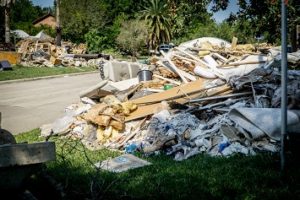Floods get lots of splashy news coverage—but flood cleanup, which can drag on for months, is less immediately dramatic. Many regions have faced the issue of removing millions of cubic yards of debris—much of it demolition debris, with contaminated or potentially hazardous wastes mixed in—in a way that protects public health.
Hurricane Katrina, Hurricane Matthew, and Superstorm Sandy all served as test cases for the management of debris removal in heavily populated areas after a flood. What have we learned? One thing is that the process takes time: It took until August 2017 for East Baton Rouge Parish, Louisiana, to clean up the flood damage from a year earlier.
Unfortunately, because decisions about debris removal are made at the local government level, the tendency is to start over from scratch each time.
Standards Are All Over the Map
After the 2011 tornadoes in Joplin, Missouri, residents were asked by the Federal Emergency Management Agency (FEMA) to sort their debris into six categories for disposal: electronics, large appliances, hazardous waste, vegetative debris, construction debris and household garbage. Houston officials used the same scheme after Hurricane Harvey—but Florida officials asked residents to sort their waste and debris from Hurricane Irma into just three categories: construction and demolition debris; vegetative debris; and normal household trash.
That’s characteristic of postdisaster waste disposal practices, according to a report issued by the U.S. Environmental Protection Agency’s (EPA) Office of the Inspector General in June 2016: The EPA has best practices guidance available, but nonhazardous solid waste disposal is largely managed by states, and there doesn’t seem to be any consistency in how the guidance is applied from one state to another after a disaster.
Keys to Planning
It is essential that state and local governments prepare to manage disaster debris in order to ensure a quick recovery from natural disasters. Business owners and community leaders should participate in this process by encouraging their state and local leadership to:
- Identify the kinds of disasters that the region may face.
- Estimate the types and quantities of debris that may be generated by each type of disaster.
- Create a plan for which roads and facilities will be cleared first and how manpower will be obtained.
- Identify available disposal facilities outside the predicted range of a disaster scenario that can accept different types of waste, and identify their capacity to manage surges in disposal.
- Identify opportunities to reuse and recycle wastes—for example, by mulching vegetative debris or recycling destroyed cars and boats.
When the EPA looked at all 10 of its regions to see which ones might be prepared for disaster debris management, it found that EPA Regions 4 and 5 had completed the most extensive preparations. Click here to see what Region 5 has done to prepare for managing disaster debris.

